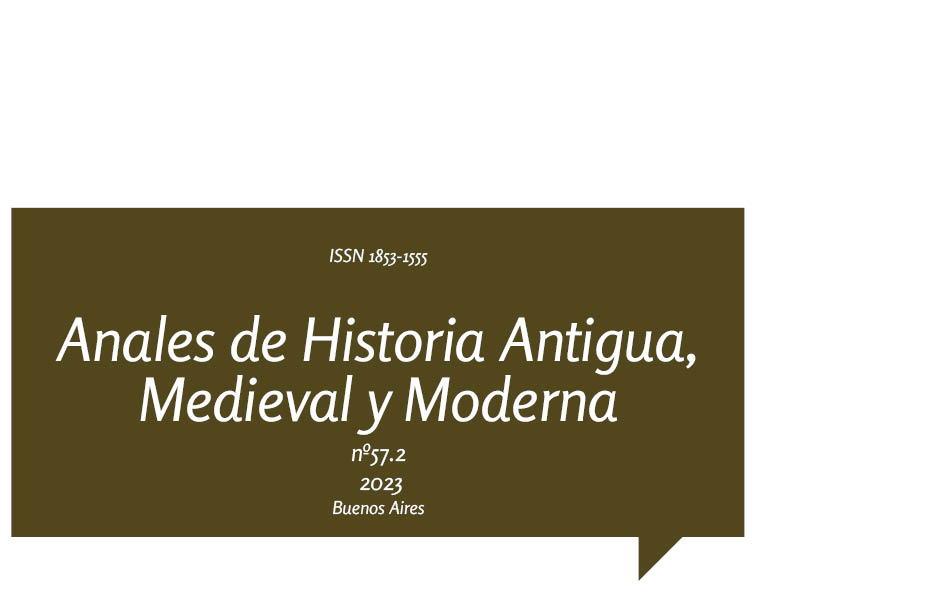Articulaciones del poder y la cultura en la Ferrara “teatral” de los Este (siglos XV y XVI).
Keywords:
Ferrara, Este family, Ariosto, Theater, Culture
Abstract
In the middle of the 15th century, Ferrara shone on the Italian peninsula as an important center of studies, attracting not only aspirants from neighboring cities, but also from other regions of Europe, beyond the Alps. The transformation of the city from the seat of power of a feudal family, the Este, into a center of production and dissemination of humanist culture took place precisely during these years, owing to the continuous financial backing from the Estense court. In this context, one of the greatest exponents of the cultural flourishing of Ferrara was undoubtedly Ludovico Ariosto (Reggio Emilia, 1474 - Ferrara, 1533), a relative of the Este family and one of the greatest poets of the Western tradition. The aim of this article is to examine the implications of part of the dramatic work of the author of the Orlando furioso in the context of the cultural policy drawn by the Estense family at the dawn of the Classical Modernity, showing aspects of his dramatic production where it is possible to detect tensions with political power in Ferrara, in particular with the court system. In a sphere different from that of mere reading, Ariosto will propose dramatic texts that offered a new space for critiquing certain aspects of the official culture to which, however, he himself belonged.Downloads
Download data is not yet available.
References
Bibliografía
Fuentes
Ariosto, L. (1997). Commedie. Ed. de Luigina Stefani. Mursia.
Ariosto, L. (2007). Cassaria. Ed. de Nora Sforza. Facultad de Filosofía y Letras de la Universidad de Buenos Aires.
Obras de consulta
Burckhardt, J. (2020). La civiltà del Rinascimento in Italia. Newton Compton.
Burke, P. (1993). El Renacimiento. Crítica.
Chiappini, L. (1967). Gli Estensi. Dall' Oglio.
D’Ancona, A. (1891). Origini del teatro italiano. II. Loeschner.
Davico Bonino, G. (ed.) (1977). Il teatro italiano. Volumen II.: La Commedia del Cinquecento (Tomo I). Einaudi.
Ferroni, G. (1980). Il testo e la scena. Saggi sulla storia del teatro. Bulzoni.
Gamrath, H. (1990). “The Herculean Addition to Old Ferrara. The Birth of Modern European Town-Planning?” En AA.VV., La corte di Ferrara e il suo mecenatismo, 1441-1598. Edizioni Panini.
Greco, A. (1996). L’istituzione del teatro comico nel Rinascimento. Liguori Editore.
Sapegno, N. (1946). Compendio di Storia della Letteratura Italiana. Volumen II: Cinquecento, Seicento, Settecento. Einaudi.
Stefani, L. (1997). “Introduzione” a las Commedie di Ludovico Ariosto (La Cassaria e I Suppositi in prosa). Mursia.
Tateo, F. (2004). “Guarino Veronese e l’Umanesimo a Ferrara.” En AA.VV., Storia di Ferrara. Vol. VII: Il Rinascimento, la letteratura. Edizioni Líbrit.
Toffanin, G. (ed.) (1935). Storia letteraria d' Italia. Il Cinquecento. Vallardi.
Wundersheimer, W. (1988) Ferrara estense. Lo stile del potere. Panini.
Fuentes
Ariosto, L. (1997). Commedie. Ed. de Luigina Stefani. Mursia.
Ariosto, L. (2007). Cassaria. Ed. de Nora Sforza. Facultad de Filosofía y Letras de la Universidad de Buenos Aires.
Obras de consulta
Burckhardt, J. (2020). La civiltà del Rinascimento in Italia. Newton Compton.
Burke, P. (1993). El Renacimiento. Crítica.
Chiappini, L. (1967). Gli Estensi. Dall' Oglio.
D’Ancona, A. (1891). Origini del teatro italiano. II. Loeschner.
Davico Bonino, G. (ed.) (1977). Il teatro italiano. Volumen II.: La Commedia del Cinquecento (Tomo I). Einaudi.
Ferroni, G. (1980). Il testo e la scena. Saggi sulla storia del teatro. Bulzoni.
Gamrath, H. (1990). “The Herculean Addition to Old Ferrara. The Birth of Modern European Town-Planning?” En AA.VV., La corte di Ferrara e il suo mecenatismo, 1441-1598. Edizioni Panini.
Greco, A. (1996). L’istituzione del teatro comico nel Rinascimento. Liguori Editore.
Sapegno, N. (1946). Compendio di Storia della Letteratura Italiana. Volumen II: Cinquecento, Seicento, Settecento. Einaudi.
Stefani, L. (1997). “Introduzione” a las Commedie di Ludovico Ariosto (La Cassaria e I Suppositi in prosa). Mursia.
Tateo, F. (2004). “Guarino Veronese e l’Umanesimo a Ferrara.” En AA.VV., Storia di Ferrara. Vol. VII: Il Rinascimento, la letteratura. Edizioni Líbrit.
Toffanin, G. (ed.) (1935). Storia letteraria d' Italia. Il Cinquecento. Vallardi.
Wundersheimer, W. (1988) Ferrara estense. Lo stile del potere. Panini.
Published
2023-12-12
How to Cite
Sforza, N. (2023). Articulaciones del poder y la cultura en la Ferrara “teatral” de los Este (siglos XV y XVI) . Anales De Historia Antigua, Medieval Y Moderna, 57(2). https://doi.org/10.34096/ahamm.v57.2.13081
Issue
Section
Dossier: Reflexiones sobre la Modernidad política europea...
Copyright (c) 2023 Anales de Historia Antigua, Medieval y Moderna

This work is licensed under a Creative Commons Attribution-ShareAlike 4.0 International License.








